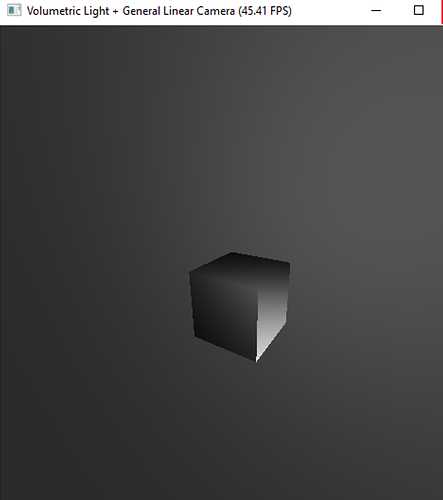首先感谢@ zixun 和 @ archibate
看了他们两个的例子,感觉很有意思。
所以,我把他们两个的例子结合一下,实现了他们的一部分功能。
我是Computer Vision小白,之前可视化结果都是调用WPF或者CUDA API。
GLC实现部分基本都看懂了,但是shadow实现部分挺多没看懂,所以感觉自己的结果不太物理哈。
要是有人能推荐一下关于shadow算法的paper,非常感谢
P.S. taiqi有自动输出gif的功能吗?
import taichi as ti
import numpy as np
import math
import time
ti.init(arch=ti.gpu)
def vec(*xs):
return ti.Vector(list(xs))
base_size = 256
pixel = ti.var(ti.f32, (2*base_size, 2*base_size))
shadow = ti.var(ti.f32, (base_size, base_size, base_size))
fram_iter = ti.var(ti.i32, ())
@ti.func
def rlight():
return vec(-1.0, 0.0, 0.0).normalized()
@ti.func
def rdstep():
return 0.006
@ti.func
def rrange():
return 750
@ti.func
def intersect_cube(ray_o, ray_dir):
xmin, xmax = -1.0, 1.0
ymin, ymax = -1.0, 1.0
zmin, zmax = -1.0, 1.0
# Solves: ro + t*rd == [x|y|z][min|max]
t_side_a = (vec(xmin, ymin, zmin) - ray_o) / ray_dir
t_side_b = (vec(xmax, ymax, zmax) - ray_o) / ray_dir
txmin = ti.min(t_side_a[0], t_side_b[0])
tymin = ti.min(t_side_a[1], t_side_b[1])
tzmin = ti.min(t_side_a[2], t_side_b[2])
txmax = ti.max(t_side_a[0], t_side_b[0])
tymax = ti.max(t_side_a[1], t_side_b[1])
tzmax = ti.max(t_side_a[2], t_side_b[2])
tmin_argmax = 1.0
if txmin > tzmin:
tmin_argmax = 0
if tymin > txmin and tymin > tzmin:
tmin_argmax = 1
t = math.inf
t_earliest_exit = ti.min(txmax, ti.min(tymax, tzmax))
t_latest_enter = ti.max(txmin, ti.max(tymin, tzmin))
if t_earliest_exit < t_latest_enter:
pass
elif tmin_argmax == 0:
t = txmin
elif tmin_argmax == 1:
t = tymin
else:
t = tzmin
return t
@ti.func
def rayleigh_phase(light_dir, ray_dir):
cos = light_dir.dot(ray_dir)
return (0.1875 / math.pi) * (1 + cos ** 2)
@ti.func
def phase_at_surface(light_dir, ray_dir, cube_pos):
realy_phase = 1.0
if(cube_pos[0] > -1.0):
realy_phase = rayleigh_phase(light_dir, ray_dir)
return realy_phase
@ti.func
def extinAt(p):
return 0.9
@ti.func
def lightAt(p, d, length):
trans = 1.0
trans *= ti.exp(- rdstep() * length * extinAt(p))
return 40 * trans
@ti.func
def radiance(ray_o, ray_dir):
trans = 1.0
total = 0.0
ray_t = math.inf
cube_t = intersect_cube(ray_o, ray_dir)
insca = 0.9
if(cube_t < ray_t):
tmp_len = int(cube_t/rdstep())
for i in range(tmp_len):
total += trans * lightAt(ray_o, ray_dir, tmp_len) * insca * rayleigh_phase(rlight(), ray_dir) * rdstep()
else:
for i in range(rrange()):
total += trans * lightAt(ray_o, ray_dir, rrange()) * insca * rayleigh_phase(rlight(), ray_dir) * rdstep()
return total
@ti.func
def compute_barycentric_coord(a: ti.Vector, b: ti.Vector, c: ti.Vector, p: ti.Vector) -> ti.Vector:
# S_abp = ab x ap / 2
# S_abc = ab x ac / 2
(pa, pb, pc) = a-p, b-p, c-p
(ca, cb) = a-c, b-c
S_abp = pa[0] * pb[1] - pa[1] * pb[0]
S_bcp = pb[0] * pc[1] - pb[1] * pc[0]
S_cap = pc[0] * pa[1] - pc[1] * pa[0]
S_abc = ca[0] * cb[1] - ca[1] * cb[0]
return ti.Vector([S_bcp / S_abc, S_cap / S_abc, S_abp / S_abc])
@ti.func
def defineGLC(frame_count: ti.f32):
distance = frame_count / 400 + 1
camera_c = ti.Vector([0.0, 0.0, distance])
# Defines the GLC.
GLC_rotate_angle = 0.0 # Change angle to 0 for a standard pinhole camera.
cos_angle, sin_angle = ti.cos(GLC_rotate_angle), ti.sin(GLC_rotate_angle)
GLC_rotater = ti.Matrix([[cos_angle, -sin_angle], [sin_angle, cos_angle]])
# Computes the transform to a rotating camera.
# --------------------------------------------
camera_rotation_radius = 6.0
# Camera rotates around the scene about 6 seconds a period.
camera_rotation_phi = frame_count / 200
# Camera looks slightly down upon the y=0 plane.
camera_rotation_theta = math.pi / 3
camera_c = camera_rotation_radius * \
ti.Vector([ti.sin(camera_rotation_theta) * ti.cos(camera_rotation_phi),
ti.cos(camera_rotation_theta),
ti.sin(camera_rotation_theta) * ti.sin(camera_rotation_phi)])
forward = ti.Vector([0.0, 1.0, 0.0], dt=ti.f32) - camera_c
up = ti.Vector([0.0, 1.0, 0.0], dt=ti.f32)
# right x up = -forward -> up x -forward = right
right = (forward.cross(up)).normalized()
up = (right.cross(forward)).normalized()
forward = forward.normalized()
camera_orientation = ti.Matrix(cols = [right, up, -forward])
return GLC_rotater, camera_c, camera_orientation
@ti.kernel
def render(frame_count: ti.f32):
GLC_rotater, camera_c, camera_orientation = defineGLC(frame_count)
A1 = GLC_rotater @ ti.Vector([0.0, 1.0])
B1 = GLC_rotater @ ti.Vector([-1.0, -1.0])
C1 = GLC_rotater @ ti.Vector([1.0, -1.0])
A0 = ti.Vector([0.0, 0.5])
B0 = ti.Vector([-0.5, -0.5])
C0 = ti.Vector([0.5, -0.5])
resolution = 2*base_size
for i, j in pixel:
# Computes the ray origin and dir using GLC.
near_point = ti.Vector([i *2.0 / resolution - 1, j * 2.0 / resolution - 1])
bc_coord = compute_barycentric_coord(A0, B0, C0, near_point)
far_point = A1*bc_coord[0] + B1*bc_coord[1] + C1*bc_coord[2]
ray_o = ti.Vector([near_point[0], near_point[1], 0.0])
ray_dir = ti.Vector([far_point[0] - near_point[0], far_point[1] - near_point[1], -1.0])
ray_o = (camera_orientation @ ray_o) + camera_c
ray_dir = (camera_orientation @ ray_dir).normalized()
pixel[i, j] = radiance(ray_o, ray_dir)
def main():
gui = ti.GUI('Volumetric Light + General Linear Camera')
fram_iter[None] = 0
while True:
for e in gui.get_events():
if e.key == ti.GUI.ESCAPE:
exit()
render(fram_iter[None])
gui.set_image(pixel.to_numpy())
gui.show()
fram_iter[None] += 1
if __name__ == '__main__':
main()
